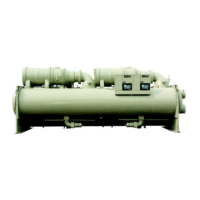6 Product Manual PM WSC/WDC
To prolong the useful life of low pressure refrigerant systems, an automatic purge unit is required as a standard
accessory. A variety of types of compressor operated and non-compressor purge systems are used. Their
efficiencies vary from 50% to 80% on older style units and are over 95% on newer high-efficiency systems. The
efficiency is a measure of the quantity of refrigerant pumped to the atmosphere along with the undesirable
contaminants. Thus the need for a purge system is accompanied by the periodic release of refrigerant into the
atmosphere, and attendant annual refrigerant cost.
All McQuay centrifugal chillers use a positive pressure refrigerant. There is...
• No absorption of impurities into the refrigerant circuit
• No breakdown of motor insulation, refrigerant or lubricant
• No increase in operating cost due to displacement of heat transfer surface by non-condensables
• No crevice corrosion and tube failure due to moisture in the system
• No annual service expense to maintain and rebuild purge unit
• No abnormal annual service expense for oil, filter, and refrigerant replacement
• No periodic emissions of refrigerant into the atmosphere
Environmentally and Operator Safe - The Real Facts
As the air conditioning industry prepares for the future, HFC-134a stands out as the logical choice when using a
balanced approach. The "balanced approach" takes into account the following facts on environmental
concerns:
• ODP-Ozone Depletion Potential; measures the impact of a substance on the depletion of the ozone layer in
the upper atmosphere. With refrigerants, this action is caused by chlorine, the first “C” in HCFC-123. HFC-
134a contains no chlorine and has a zero ODP.
• GWP-Global Warming Potential; measures the contribution of a substance to the greenhouse gas effect
which causes global warming. This is a pound to pound comparison, discounting the application of the
substance and any other effects caused by its use. The numbers, relative to CO
2
for a 100 year integration
time horizon are HCFC-123=90, HFC-134a=1300, HCFC-22=1500. Manufacturers utilizing HCFC-123 would
have you believe that GWP is the primary measurement of global warming. This is untrue.
• TEWI-Total Equivalent Warming Impact; is a combination of the
refrigerant GWP, unit refrigerant emissions rate, and the refrigeration
system’s energy efficiency. Science has agreed that a systems
approach is necessary to evaluate the real effect of a substance on
global warming. This is TEWI. In a chiller, the contribution of the
GWP is insignificant when compared to the effect of a unit’s power
needs translated to power plant CO
2
emissions. There is no
meaningful difference between the TEWI of HFC-134a, HCFC-22 or
HCFC-123. The percentages shown on the right will vary slightly
depending on unit refrigerant loss and on the efficiency of local
power generation. Bottom line, equipment operators should keep
equipment leak free and operate as efficiently as possible. Since
annualized energy consumption (think power plant output) is a basis
for measurement, McQuay’s superior part load efficiencies mean
lower overall power plant CO
2
emissions and lower TEWI.
• True System Efficiency (KW/ton or COP); deals with the total power consumption (annual kWh) of a chiller
system including auxiliaries such as pumps, purge units, Pre-Vac heaters and fans---of great importance in
determining facility energy cost and ultimate power plant CO
2
emissions.

